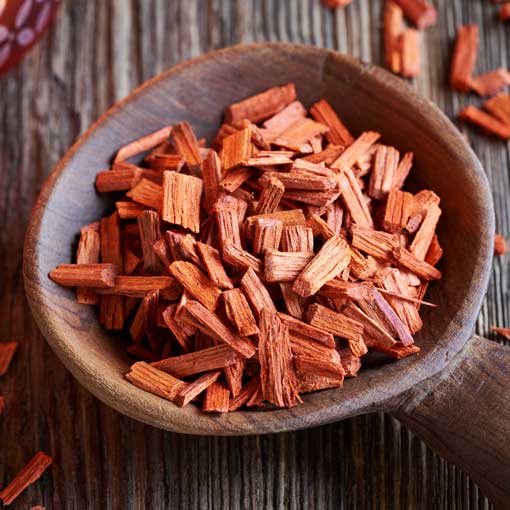- 11 July 2023
- 10 mins read
In the world of natural remedies, there exists a hidden gem that has captivated the attention of Ayurvedic practitioners for centuries. Welcome to the realm of Red Sandalwood, a mystical and revered herb known for its remarkable benefits.
With its vibrant red hue and potent properties, Red Sandalwood, scientifically known as Pterocarpus Santalinus, has carved a significant place in traditional medicine and skin care practices.

From soothing troubled skin to unveiling a radiant complexion, this extraordinary botanical holds secrets waiting to be discovered. Join us on a journey to unravel the captivating allure and the untold wonders of Red Sandalwood.
Significance Of Red Sandalwood In Ayurveda
The significance of Red Sandalwood in Ayurveda is profound and deeply rooted in ancient wisdom. Ayurveda, the traditional Indian system of medicine, recognizes Red Sandalwood, also known as Raktachandan or Lal Chandan, as a highly valuable herb with diverse benefits.
In Ayurveda, Red Sandalwood is revered for its cooling, soothing, and astringent properties, making it particularly beneficial for balancing Pitta dosha, which is associated with heat and inflammation. It is widely used to address various skin concerns such as acne, blemishes, and infections.

The herb's ability to pacify aggravated Pitta dosha is remarkable. It helps soothe skin inflammations, rashes, and sunburns, providing relief from itching, irritation, and redness. The cooling nature of Red Sandalwood makes it an excellent remedy for troubled skin conditions.
What experts say -
“One of the notable uses of Red Sandalwood in Ayurveda is its incorporation into face packs and topical applications. By doing so, it acts as a natural cleanser, effectively removing impurities and restoring the skin's vitality. It also helps balance oil production, addressing issues related to excess sebum secretion.” - Dr. Vinny Narayanan
Top 10 Benefits Of Red Sandalwood For Skin
Regular use of Red Sandalwood-based skincare products can help diminish the appearance of wrinkles, fine lines, and age spots, promoting skin elasticity, firmness, and a youthful complexion. Let’s explore all its benefits for skin -
- Skin Brightening: Red Sandalwood is renowned for its ability to enhance the complexion and promote a natural glow. Regular use helps brighten the skin, giving it a more radiant and youthful appearance.
- Acne Treatment: Red Sandalwood possesses antimicrobial and anti-inflammatory properties that make it effective in treating acne. It helps reduce bacteria on the skin and soothes inflammation, aiding in the prevention and healing of acne breakouts.
- Anti-Aging Effects: The anti-aging properties of Red Sandalwood are highly valued. It helps reduce the appearance of wrinkles, fine lines, and age spots, promoting a more youthful and rejuvenated complexion.
- Skin Soothing and Calming: Red Sandalwood has cooling and soothing properties, making it beneficial for calming irritated and sensitive skin. It provides relief from itchiness, redness, and skin discomfort.
- Oil Balancing: Red Sandalwood helps balance oil production in the skin, making it suitable for both oily and combination skin types. It helps control excess sebum secretion and prevent clogged pores, leading to a clearer complexion.
- Skin Detoxification: Red Sandalwood has natural detoxifying properties that help cleanse the skin and remove impurities. It aids in the removal of toxins and pollutants, promoting healthier-looking skin.
- Skin Lightening: Red Sandalwood is known for its skin lightening effects. It helps fade dark spots, hyperpigmentation, and blemishes, resulting in a more even-toned complexion.
- Anti-Inflammatory Action: Red Sandalwood possesses anti-inflammatory properties that can help soothe various skin conditions, including eczema, psoriasis, and dermatitis. It calms skin irritation and reduces redness.
- Natural Exfoliation: Red Sandalwood can act as a gentle exfoliant, helping to remove dead skin cells and unclog pores. Regular exfoliation with Red Sandalwood can improve skin texture and promote a smoother complexion.
- Skin Healing: Red Sandalwood aids in the healing of wounds, cuts, and burns due to its antibacterial and antiseptic properties. It also accelerates the healing process, prevents infections, and reduces scarring.
What experts say -
“The remarkable benefits of Red Sandalwood for the skin can be attributed to its rich reservoir of bioactive compounds, including santalin and a diverse array of phenols, alkaloids, flavonoids, and more, which work synergistically to enhance skin health and radiance.” - Dr Gopan G

Bioactive Compounds Of Red Sandalwood
Red Sandalwood, also known as Red Chandan, harbors a treasure trove of bioactive compounds that contribute to its esteemed medicinal and skincare properties. Among these compounds, minerals such as zinc, cadmium, strontium, uranium, and copper can be found in the plant. However, one of the most significant bioactive compounds in Red Sandalwood is santalin, which imparts its distinctive red color.
Moreover, Red Sandalwood contains a diverse array of biologically active compounds, including phenols, alkaloids, saponins, flavonoids, glycosides, triterpenoids, sterols, tannins, isoflavones, glucosides, savinin, and calocedrin. These compounds play vital roles in the plant's therapeutic effects and contribute to its overall efficacy.
The heartwood of Red Sandalwood specifically accumulates elements like strontium, cadmium, zinc, copper, and uranium. Additionally, various important phytochemical constituents have been extracted from different parts of the Red Sanders plant.
The heartwood itself boasts an insoluble or sparingly soluble red wood dye, making it highly sought after. It also contains the pigment Santalin (Santalin A and B), carbohydrates, steroids, anthocyanins, saponins, tannins, phenols, triterpenoids, flavonoids, glycosides, and glycerides.
Furthermore, Red Sandalwood reveals other noteworthy heartwood components, including Homopterocarpin, Liquiritigenin, Isopterocarpolone, Pterocarpol, Isoliquiritigenin, Pterocarptriol, and PterostiIbene. These compounds collectively contribute to the diverse range of therapeutic benefits associated with Red Sandalwood.
As we delve deeper into the realm of Red Sandalwood's bioactive compounds, a fascinating world of healing potential unfolds. The intricate synergy of these compounds creates a powerhouse of natural goodness, making Red Sandalwood a prized botanical resource with significant applications in traditional medicine and skincare practices.

How To Use Red Sandalwood For Skin
When it comes to using Red Sandalwood for skin, incorporating it into your skincare routine is simple and effective. Here are some ways to utilize this remarkable herb:
- Red Sandalwood Paste: Create a paste by mixing Red Sandalwood powder with water, rose water, or aloe vera gel. Apply the paste to your face and leave it on for about 15-20 minutes before rinsing off with lukewarm water. This method is great for overall skin brightening, reducing acne scars, and achieving a youthful glow.
- Face Packs: Combine Red Sandalwood powder with other skin-loving ingredients like turmeric, honey, yogurt, or lemon juice to create nourishing face packs. Apply the mixture evenly to your face and neck, and leave it on for 20-30 minutes. Rinse off with water and enjoy the rejuvenating effects.
- Spot Treatment: For targeted treatment of acne or blemishes, make a paste of Red Sandalwood powder, one tablespoon turmeric powder and a pinch of camphor with rosewater. Apply the paste to the afflicted areas immediately. Apply it directly to the affected areas and leave it on overnight. Rinse off in the morning and witness the soothing and healing benefits.
- Red Sandalwood Water: Soak Red Sandalwood chips or powder in water overnight. The next day, strain the water and use it as a refreshing facial mist or toner. This gentle concoction helps balance oil production, reduce inflammation, and promote a clearer complexion.
- Red Sandalwood in Skin Care Products: Look for skincare products that contain Red Sandalwood as an active ingredient. These can include face creams, serums, masks, or cleansers. Incorporating such products into your daily routine can offer long-term benefits for your skin.
Remember to perform a patch test before applying Red Sandalwood products to your face, especially if you have sensitive skin.
Other Benefits Of Red Sandalwood
Beyond its skin-related benefits, Red Sandalwood offers a range of other valuable advantages.
- Aromatic and Calming Properties: Red Sandalwood possesses a pleasant and soothing aroma, making it a popular choice for aromatherapy. Its calming properties can help alleviate stress, anxiety, and promote relaxation.
- Spiritual and Meditation Practices: Red Sandalwood holds significant spiritual significance in various cultures and is often used during rituals, ceremonies, and meditation practices. Its grounding and centering properties help enhance focus, promote mindfulness, and deepen spiritual connection.
- Anti-Inflammatory and Analgesic Effects: Red Sandalwood exhibits anti-inflammatory properties, which can help alleviate inflammation-related conditions like arthritis, joint pain, and muscle soreness. It may provide relief from pain and discomfort when used in the form of oils, balms, or creams.
- Hair Care Remedy: Red sandalwood is not limited to skincare; it also provides several benefits for hair health. It nourishes the scalp, strengthens hair follicles, and promotes hair growth. Regular use of red sandalwood paste or oil can help combat dandruff, prevent hair fall, and enhance hair texture, leaving your locks healthy, lustrous, and voluminous.
- Regulates Diabetes: The active components present in Red Sandalwood have been found to play a key role in raising and regulating blood sugar levels. It can enhance insulin secretion and help prevent damage to pancreatic cells, making it beneficial for individuals with diabetes.
- Purifies Blood: Red Sandalwood is known for its blood-purifying properties. It aids in healthy blood purification and fluid retention. With its diuretic properties, it promotes frequent urination, helping to cleanse the urinary tract and eliminate toxins from the body.
- Improves Circulation: The extract from Red Sandalwood supports healthy blood circulation and nerve function. Its beneficial effects on the circulatory system make it a popular choice for masks and scrubs, providing deep cleansing and rejuvenation for the skin.
How To Identify Red Sandalwood?
Identifying Red Sandalwood can be a fascinating endeavor, considering its unique characteristics. Here are some key features to help you identify this precious tree:
- Growth and Appearance: Red Sandalwood is a slow-growing tree that takes approximately 30 years to develop its dense heartwood. It thrives in hilly terrain and typically reaches a height of about 10-15 feet. The bark of Red Sandalwood is dark brown and becomes perforated as the tree matures.
- Aromatic Properties: Unlike white sandalwood, the bark of Red Sandalwood does not possess any noticeable fragrance. However, when the wood is freshly cut or sanded, it releases a sweet and woody aroma that adds to its allure.
- Heartwood Composition: The heartwood of Red Sandalwood accumulates a variety of earth elements such as strontium, cadmium, zinc, copper, and uranium. These minerals contribute to the distinct properties and appearance of Red Sandalwood.
- Resin and Color: Red Sandalwood exudes a remarkable red resin with pink streaks. The heartwood is known for its rich red or golden color, which is highly valued for various applications.
- Leaves and Flowers: Red Sandalwood has leaves composed of three leaflets, and its flowers grow on short stems. The tree produces large yellow raceme flowers that form simple or sparingly branched racemes, adding to its aesthetic beauty.
- Fruits and Seeds: The fruits of Red Sandalwood are obliquely orbicular, measuring 3 to 9 cm in diameter and featuring a concavely curved stripe. The seeds are reddish-brown, smooth, leathery, and approximately 1 cm in length.

It is important to note that due to overexploitation for its timber, Red Sandalwood is listed as an endangered species. Therefore, it is crucial to source Red Sandalwood responsibly and support conservation efforts to protect this remarkable tree.
FAQs About Red Sandalwood
1. Why Is Red Sandalwood So Expensive?
Red Sandalwood is considered expensive due to several factors. Firstly, the slow growth rate of Red Sandalwood trees, which takes around 30 years for the heartwood to fully develop, contributes to its scarcity.
Additionally, the high demand for Red Sandalwood in various industries, including cosmetics, woodworking, and traditional medicine, further drives up its price. Furthermore, Red Sandalwood is listed as an endangered species, leading to strict regulations and limited availability, which also impacts its cost.
2. What are the side effects of Red Sandalwood?
While Red Sandalwood is generally safe for topical use, some individuals may experience mild allergic reactions or skin irritation. It is recommended to perform a patch test before applying Red Sandalwood products to the entire face or body.
Ingesting Red Sandalwood or using it in excessive amounts may have adverse effects and is not recommended without proper medical guidance. It is always advisable to consult with a healthcare professional or dermatologist before using Red Sandalwood products, especially if you have any known allergies or sensitivities.
3. How is Red Sandalwood different from White Sandalwood?
Red Sandalwood (Pterocarpus santalinus) and White Sandalwood (Santalum album) are two different species of trees with distinct characteristics. Red Sandalwood is valued for its rich red or golden heartwood, which contains bioactive compounds such as santalin that give it a vibrant color. It is primarily used in cosmetics, woodworking, and traditional medicine.
On the other hand, White Sandalwood is known for its aromatic properties and is used primarily in perfumes, incense, and skincare products. The heartwood of White Sandalwood has a pale yellow or tan color and emits a pleasant fragrance.
4. How To Use Red Sandalwood for different skin types?
For oily and combination skin: Mix Red Sandalwood powder with Rose Water or Aloe Vera gel to create a paste. Apply it to the face, leave it on for 15-20 minutes, and rinse off with water. This helps control excess oil, prevent breakouts, and improve skin texture.
For dry and sensitive skin: Mix Red Sandalwood powder with honey or milk to create a nourishing face mask. Apply it to the face, leave it on for 15-20 minutes, and rinse off gently. This helps hydrate the skin, soothe irritation, and promote a healthy glow.
For normal skin: Mix Red Sandalwood powder with plain yogurt or cucumber juice to create a refreshing face pack. Apply it to the face, leave it on for 15-20 minutes, and rinse off with water. This helps maintain the skin's balance, improve complexion, and provide a revitalized look.
Shreya Dalela is a certified Yoga instructor and a professional dancer trained at The Danceworx. She’s passionate about Ayurveda and holistic living with over 6 years of experience in doing extensive research and content creation in the domain.

Certified Ayurvedic Doctor (Central Council of Indian Medicine) working in Kama Ayurveda as an Assistant Training Manager.




















